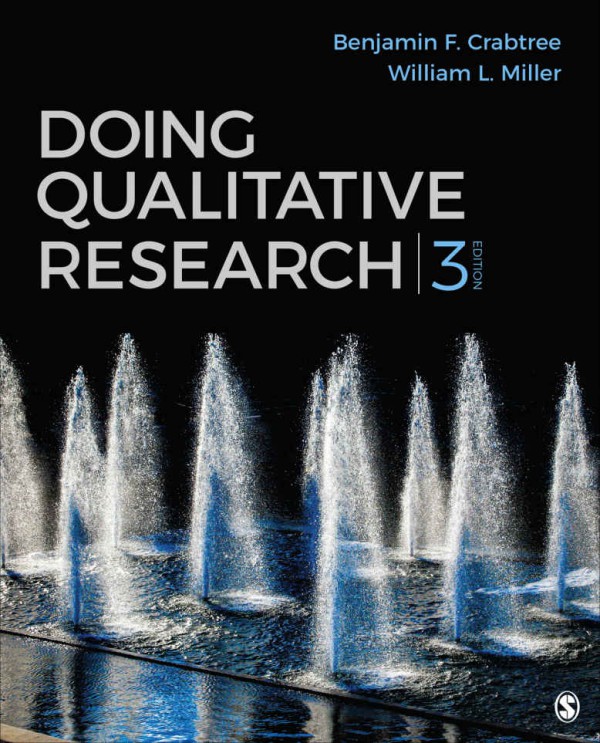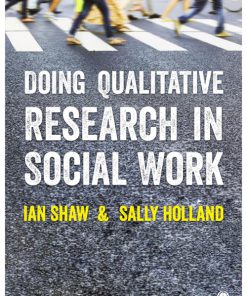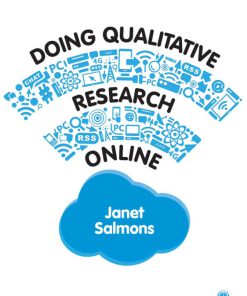Doing Qualitative Research 3rd Edition by Benjamin Crabtree, William Miller ISBN 9781506302829 1506302823
$50.00 Original price was: $50.00.$25.00Current price is: $25.00.
Authors:Benjamin F. Crabtree; William L. Miller , Series:Psychology [29] , Tags:Qualitative research; Recherche qualitative Sciences; sociales Recherche MeÌthodologie , Author sort:Crabtree, Benjamin F. & Miller, William L. , Languages:Languages:eng , Published:Published:Aug 2022 , Publisher:Sage Publications , Comments:Comments:”The long-awaited third edition of Doing Qualitative Research by Benjamin F. Crabtree and William L. Miller is out! Co-create your own inspired research stories with this reader-friendly text on qualitative methods, design, and analysis. Written for students and researchers with little to no qualitative experience, this clear and concise book will quickly get readers up to speed doing truly excellent qualitative research. The first four chapters of the book set the stage by contextualizing qualitative research within the overall traditions of research, focusing on the history of qualitative research, the importance of collaboration, reflexivity, and finding the appropriate method for your research question. Each part then addresses a different stage of the research process, from data collection, data analysis and interpretation, and refocusing on the bigger picture once your research is complete. Unique chapters cover case study research, intervention studies, and participatory research. The authors use their experiences and knowledge to provide both personal and published research stories, ending each chapter with open-ended discussion questions to further reader contemplation. With an abundance of clinical research examples featuring a variety of qualitative methods, Doing Qualitative Research encourages researchers to learn by doing and actively experiment with the tools and concepts presented throughout the book”
Doing Qualitative Research 3rd Edition by Benjamin Crabtree, William Miller – Ebook PDF Instant Download/Delivery. 9781506302829 ,1506302823
Full download Doing Qualitative Research 3rd Edition after payment
Product details:
ISBN 10: 1506302823
ISBN 13: 9781506302829
Author: Benjamin Crabtree, William Miller
Doing Qualitative Research 3rd Edition Table of contents:
Part I Read Me First: Overview of Qualitative Research
Chapter 1 Clinical Research: A Qualitative Trail Map Within a Mixed-Methods World
What’s Coming?
A Mixed-Methods Research Approach
Research Aims
Worldviews, Paradigms, and Theory
Choosing a Research Style and Methods
Qualitative Methods: A Map, Sampling, and Design Overview
Sampling
Collecting Data
The Interpretive Process
From Whence It Came: Qualitative Research Traditions
Summary
Questions at the Edge
Chapter 2 Creating Collaborative Space and Research Teams
What’s Coming?
A Typology of Cross-Disciplinary Research
A Collaborative Team Story
Creating Collaborative Space and Research Teams
Developing Collaborative Research Relationships
Barriers to Collaborative Process
Clearing the Flow for Collaborative Conversations
Summary
Questions at the Edge
Chapter 3 Reflexivity
What’s Coming?
Tools for Doing and Teaching Reflexivity
Traps of Perception and Understanding
Reflexivity Tools
Reflexivity Before the Fieldwork Begins
Reflexivity During Data Collection
Reflexivity During Analysis and Interpretation
Reflexivity During Dissemination
Summary
Questions at the Edge
Chapter 4 Research Design: Start With the Stories
What’s Coming?
A Clinical Story
Anomalies and Research Questions
How Are Healing Relationships Developed and Maintained in Primary Care?
What Are Patient Preferences Regarding the Role of the Primary Care Physician in Their Extended Cancer Follow-Up Care?
How Do Exemplar Primary Care Practices Deliver Care for Cancer Survivors Like Mrs. Brown?
What Are the Experiences of Early Implementers of Primary Care-Focused Cancer Survivorship Delivery Models?
What Are Practices Experiences When Participating in a Quality Improvement Intervention?
Summary
Questions at the Edge
Part II Discovery: Data Collection Strategies
Chapter 5 Depth Interviews
What’s Coming?
Partnership, Communicative Performance, and Conversational Journey
Depth Interviews
Preparing for the Journey: The Literature and Beyond
Designing: Selecting the Actors and Creating the Script
Preparing: Staging the Scene
Interviewing: Let the Improvisation Begin
Debriefing: Capturing Context
Transcribing: The Final Script
A Plethora of Primary Care Examples
Interviewer Training
Consent and Ethical Considerations
Summary
Questions at the Edge
Chapter 6 Group Interviews and Focus Groups
What’s Coming?
The Larger Genre of Group Interviews
Focus Groups
What Types of Questions Are Best for Focus Groups?
Sampling in Focus Groups
Recruitment of Participants
Number of Groups
Group Size
Length of Focus Groups
The Role of the Moderator
Developing the Interview Guide
Recording and Other Logistics
Moderating Focus Groups
Transcription Options
Analysis and Interpretation Is Tricky
Reporting Focus Group Findings
Consent and Ethical Considerations
Summary
Questions at the Edge
Chapter 7 Observation
What’s Coming?
Why Participant Observation?
A Primer on Participant Observation
Overview of the Project
Into the Field and Gaining Entry
Initial Contact
Establishing Rapport
The Mechanics of Observation
The Participation Continuum
Informants
Fieldnotes: A Dialogue With Self
What: The Content of Fieldnotes
How: The Form of Fieldnotes
When: The Process of Writing Fieldnotes
Technologies for Recording and Managing Fieldnotes
Individual Versus Team Research
Some Tips on Training and Skill Building
Informed Consent and Ethics
Summary
Questions at the Edge
Chapter 8 Key Informant Interviews
What’s Coming?
What Are Key Informant Interviews?
Why Use Key Informants?
Who Is a Key Informant?
How to Select Key Informants?
Learning From Key Informants
Questioning
Language
Texts and Sources
Ethical Considerations
Applications in Primary Care
Key Informants Within an Ethnographic Study
Key Informants in Case Study Research
Key Informants as Sole Source of Data
Key Informant to Enhance a Depth Interview Guide
Limitations of Key Informant Interviews
Summary
Questions at the Edge
Chapter 9 Material Artifacts
What’s Coming?
Analyzing and Interpreting Television Commercials
Photographs as Artifacts
Collecting and Analyzing Online Artifacts
Collecting Documents in a Case Study
Summary
Questions at the Edge
Part III Analysis and Interpretation Strategies
Chapter 10 The Dance of Interpretation and Frustrations of Sisyphus
What’s Coming?
Where Are We?
Interpretation as Dance
Who Are the Dancers?
How to Dance?
Describing
Organizing
Connecting
Corroborating/Legitimating
Representing the Account
Tools for the Dance
Selecting the Tools
Principles, Pitfalls, and Pearls
Questions at the Edge
Chapter 11 Editing Organizing Style of Analysis
What’s Coming?
Stepping Through the Process
Step 1: Text Segment Identification and Making Comments
Step 2: Expansion of Comments
Step 3: Comparison of Expanded Comments
Step 4: Theme Development
Step 5: Comparison of Interview Themes
Published Examples
Three Focus Groups Is a Piece of Cake
Editing Also Possible With Many More Interviews
Dancing With Your Data: Immersion Before Editing
More Dancing Using All Three Styles: Editing, Template, and Immersion
Using an Editing Organizing Style Within a Large Dataset
Summary
Questions at the Edge
Chapter 12 Template Organizing Style of Analysis
What’s Coming?
The Dance and Use of Codes in Template and Editing Styles
Examples of Template Organizing Style
Using an A Priori Codebook
Creating and Using an Evolving Codebook
Using a Post Hoc Confirmatory Codebook
The Mechanics of a Template Organizing Style
Approaches for Developing a Codebook or Code Manual
Codebook Illustration
Coding Text
Sorting Segments
Connecting and Corroborating/Legitimating
Summary
Questions at the Edge
Chapter 13 Immersion/Crystallization Organizing Style of Analysis
What’s Coming?
The Requirements
The Core Process of Immersion/Crystallization
Initial Engagement With the Topic and Reflexivity
Crystallization During Gathering Process
Immersion and Crystallization of Insights During Interpretive Process
Corroboration/Legitimation and Alternative Interpretations
Representing the Account
Immersion/Crystallization Variations, Influences, and Pitfalls
Variations and Influences
Pitfalls
Summary
Questions at the Edge
Chapter 14 Computers and Data Management
What’s Coming?
Types of CAQDAS Programs
A Brief Summary of Five Common CAQDAS Programs
To the Field!
Pearls and Pitfalls
Summary
Questions at the Edge
Part IV Special Applications
Chapter 15 Case Studies
What’s Coming?
Background
Preparing for the Journey
Setting the Context
Living It
Getting Ready
Sampling: Finding a Place
Entering the Field
Collecting Data
Gathering Additional Data
Processing and Managing Data
Comparative Case Analysis Strategies
Spelunking: The Dark Side
Crawling Toward Light: Turns and Decisions
Single Case Studies
Summary
Questions at the Edge
Chapter 16 Qualitative Methods in Intervention Studies
What’s Coming?
Using Qualitative Assessments to Tailor Interventions
Conducting Process Evaluations During Interventions
Conducting Independent Evaluations of Research Initiatives/Programs
Qualitative Input on Intervention Design and on a Learning Evaluation
Summary
Questions at the Edge
Chapter 17 Qualitative Methods in Participatory Healthcare Research
What’s Coming?
Participatory Research: Typical Forms, Assumptions, and Issues
Participatory Research in Health Care
Challenges
Doing Participatory Research: Four Examples
Designing a Knowledge Workshop in Participatory Action Research
Boot Camp Translation in a PBRN Using a CBPR Framework
Using Online Community Salons With Community Organizations
Using Photovoice in Participatory Research
The Way Beyond
On Participation
What’s in a Name?
Summary
Questions at the Edge
Part V The Rest of the Story
Chapter 18 Doing Good Qualitative Research
What’s Coming?
Seven Essentials for Good Qualitative Research
Question/Design Match
Information-Rich Sampling
Iteration
Context
Incongruous Evidence
Self-Reflexivity
Group Reflexivity
Rules Are Written for the Novice
Summary
Questions at the Edge
Chapter 19 Getting Funded and Getting Published
What’s Coming?
Getting Funded
Writing the Cancer Survivor Care Application
Significance: Start With the Story
Investigators: Promoting Yourself and Your Team
Innovation: What’s New and Unique Here?
Approach: Avoid Jargon and Give Details
Environment: No Place Like Home
Some Final Thoughts on Getting Funded
Getting Published
Finding the Right Journal
What Should Be in Your Journal Article
Relevance
Question/Design Match
Information Rich Sampling
Iteration
Context
Accounting for Incongruous Evidence
Reflexivity: Self and Group
Believability
Summary
Questions at the Edge
Chapter 20 The Future of Qualitative Methods in a Mixed-Methods World
What’s Coming?
Training for the Future
Keeping Up With Accelerating Change
Technology, the Locations of Social Space, and Politics
Climate Change, Ecology, and Health
Ways of Knowing, Research Design, and Knowledge Democracy
Mixed-Methods Imperative and Real Integration
Changing the Evidence: Round Tables, Solidarity Research, and Knowledge Democracy
Final Thoughts
Questions at the Edge
References
Index
People also search for Doing Qualitative Research 3rd Edition:
doing qualitative research in education settings
what is qualitative research in education
what is a research paradigm for qualitative research
doing qualitative research in a digital world
You may also like…
eBook PDF
Doing Qualitative Research in Education Settings 1st edition by Amos Hatch 9780791487945 0791487946
eBook EPUB
Doing and Writing Qualitative Research 3rd Edition by Adrian Holliday ISBN 9781473968301 1473968305











